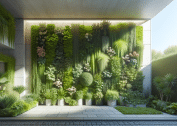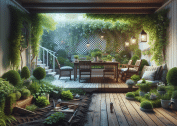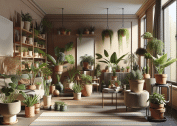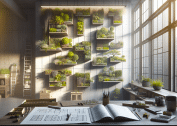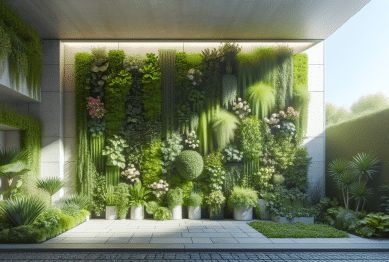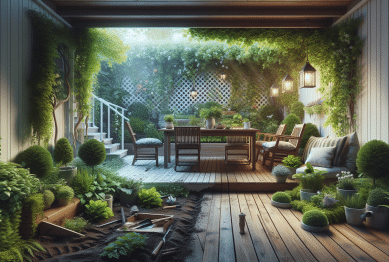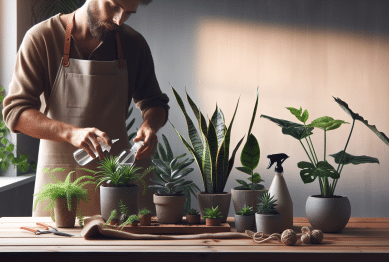Discover clever techniques that help a small garden appear bigger while maximizing its usability and beauty. This guide covers layout tricks, plant selection, outdoor lighting, and smart furnishing—a practical approach to transforming compact outdoor spaces.
Embracing Vertical Gardening Techniques
When space is tight, vertical gardening offers a creative solution for making a small garden appear much larger than it is. By using walls or fences for climbing plants, pocket planters, and tall trellises, the eye is naturally drawn upward, adding a feeling of height and depth. Vertical gardening can also maximize plant diversity in compact spaces, allowing for more flowering vines, trailing succulents, and lush greenery without crowding the ground. The added layers produce visual richness and create the perception of a more expansive garden footprint.
Innovative vertical supports such as living walls or vertical pallet gardens blend function with style. These options not only free up precious ground area, but also enhance privacy and act as living art pieces. When selecting plants, try mixing textures—a blend of bushy herbs, trailing ivy, and colorful annuals can construct dynamic scenes. Modular planters can be easily rearranged, changing the arrangement’s look seasonally or as your taste evolves. These flexible approaches work for patios, balconies, and yard corners alike, giving you plenty of room for creativity.
Vertical gardening has practical benefits beyond looks. It improves air flow and sunlight distribution, leading to healthier plants—especially in crowded spots. Vertical planters can help minimize some pests and make watering routines more efficient. With many vertical garden kits and DIY tutorials now available, anyone can find solutions that suit their style and space constraints (https://extension.umn.edu/how/grow-vertical-gardens).
Optimal Plant Choices for Depth and Interest
Smart plant selection is crucial in maximizing the sense of depth in a small garden. Opt for a narrow color palette with pops of accent hues to keep the area cohesive and uncluttered. Shades of green, soft pastels, or silvery foliage can establish a calming atmosphere, while one or two bold colors add controlled drama. Try layering tall grasses at the back, sun-loving perennials at mid-height, and low ground covers along pathways. This staged look pulls the eye deeper into the scene, providing a structured, spacious feel.
Evergreen shrubs or columnar trees, such as junipers or Italian cypress, are excellent for vertical interest and remain visually appealing year-round. Dwarf or slow-growing species fit well in containers and borders without overwhelming the space. When planting in containers, experiment with the thriller-filler-spiller technique—choose one striking focal plant, surround it with supportive foliage, and let some varieties cascade over the edge for movement and softness. These approaches let you make the most of every square meter, ensuring seasonal variety and year-round vibrancy.
The use of reflective surfaces—shiny leaves, chartreuse greens, or even a garden mirror—plays visual tricks that extend the sense of space. Light-colored mulches and gravel paths further brighten the area, helping bounce light around and delineate boundaries in a subtle way. Planting in groups rather than one-off specimens builds rhythm and avoids clutter, making small spaces appear intentionally designed (https://www.rhs.org.uk/garden-design/ideas/small-gardens).
Designing Effective Outdoor Lighting
Outdoor lighting isn’t just practical. It has the power to transform a small garden after dusk, expanding the perceived boundaries and introducing a magical atmosphere. Focused lighting can draw attention to the garden’s best features—such as a sculptural tree or textured wall—while soft ground lights along paths make the area look larger. The strategic use of uplights, fairy lights, and low-voltage LED fixtures can shape mood and direct movement, letting you enjoy the garden late into the evening.
Low-level lighting along the perimeter blurs the edges of a small space. By illuminating boundaries gently, the garden seems to stretch farther. You can use solar-powered stake lights, lanterns, or even glowing planter pots for flexible, sustainable accenting. Avoid over-lighting—too many bright spots can flatten the atmosphere and diminish depth. Dimmers or smart lighting systems offer control to match various moods and activities, from relaxed dining to vibrant social gatherings—adding flexibility to your outdoor routine.
Mirrored features combined with lighting can amplify the visual effect. For example, a small water bowl with underwater LEDs offers a double play of light, shadow, and reflection. Swapping between warm and cool tones helps highlight certain plants at different times of night. Creative lighting opens up fresh possibilities, even in shadowy corners or along fences that once felt uninviting (https://www.energy.gov/energysaver/outdoor-lighting).
Smart Furniture Arrangement and Selection
Furniture choice has a direct impact on how open or crowded a small garden feels. Slimline furniture with open designs, such as metal bistro sets or benches with slatted seats, encourages airflow and light, preventing the feeling of congestion. Multifunctional options—like storage benches or collapsible tables—keep utilities integrated without sacrificing valuable floor space. By positioning furniture along borders or tucked into garden niches, more open space remains in the center, fostering an airy impression.
Consider the scale. Oversized furniture can instantly shrink a compact area, while appropriately sized pieces make the garden more usable and accessible. Moveable chairs and tables add flexibility, allowing different layouts for dining, relaxing, or hosting friends. Using a pair of small armchairs instead of one large sofa lets you shape conversation zones and enjoy fresh vantage points throughout the garden. Cushions and soft throws, in similar hues to the garden’s planting scheme, tie everything together and make the space comfortable for longer stays.
Transparent or light-colored furniture, such as acrylic stools or glass-topped tables, seems to “disappear” visually, making the surroundings look less crowded. Hanging seats or hammocks mounted to strong supports unlock vertical enjoyment—further freeing the ground for plants and pathways. Mobile planters on wheels can double as informal dividers or extra tables, adapting easily to changing needs (https://www.bhg.com/outdoor/furniture/furniture-ideas/small-garden-furniture-solutions/).
Creating the Illusion of Space with Colors and Materials
Color and material choice matters greatly in a small garden. Pale paving stones, white-washed walls, and pastel planters illuminate the space, making it seem broader and lighter. Smooth pebbles or gravel reflect sunlight, brightening walkways and extending usable areas visually. Contrasting textures—a blend of rough stone, smooth ceramics, and leafy foliage—break up monotony while still appearing united when color themes echo each other. These approaches draw light into shaded spaces and help disguise hard boundaries.
Repeating colors in plantings, pots, and accessories helps unify the view and avoids chopped-up visuals that can make spaces seem smaller. Painted feature walls or patterned screens at the end of sight lines lure attention outward, giving the illusion of added depth. Transparent barriers, such as glass balustrades or mesh screens, separate spaces without blocking views, increasing the feeling of openness. Surface materials that echo natural colors, like light woods and stone, offer warmth while amplifying daylight effects.
Reflective items—garden mirrors, stainless steel sculptures, or even a simple mirror mounted on a shed—visually double plantings and hardscape, tricking the eye into thinking the garden is larger. Just ensure mirrors are placed where they won’t focus sunlight. Tiny tweaks like angled paths, diagonal stone layouts, or meandering walkways also create routes that slow the journey and suggest greater distance. Strategic colors and textures make even snug gardens feel relaxed and generously scaled (https://www.gardendesign.com/small-gardens/design-ideas.html).
Practical Maintenance Tips for Lasting Results
Upkeep is essential for maintaining a visually appealing compact garden. Regular pruning keeps plants tidy and prevents overcrowding, letting each species shine. Choose low-maintenance perennials and drought-tolerant ground covers to save time and keep the space attractive with less effort. Consistent care reduces clutter and encourages lush but controlled growth, which makes the garden feel settled and intentional.
Irrigation methods like drip lines or self-watering planters offer efficient watering without wasting water or crowding the area with hoses. Applying mulch retains soil moisture, lessening the need for frequent watering and deterring weeds. These small steps help preserve a healthy look across seasons. Regular cleaning of hardscape, mirrors, and lighting also preserves brightness and clarity, ensuring that the garden always appears well tended.
Periodic rearrangement of portable furnishings and planters introduces variety—keeping the layout fresh and allowing spaces to adapt as needs change. Harvest spent blooms, tidy up fallen leaves, and refresh faded accessories regularly. This light-touch maintenance prevents the small garden from growing wild and preserves the “roomy” effect, even as nature’s rhythms change through the year (https://hgic.clemson.edu/factsheet/smart-gardening-maintenance-tips/).
References
1. University of Minnesota Extension. (n.d.). Grow vertical gardens. Retrieved from https://extension.umn.edu/how/grow-vertical-gardens
2. Royal Horticultural Society. (n.d.). Small garden ideas. Retrieved from https://www.rhs.org.uk/garden-design/ideas/small-gardens
3. U.S. Department of Energy. (n.d.). Outdoor lighting. Retrieved from https://www.energy.gov/energysaver/outdoor-lighting
4. Better Homes & Gardens. (n.d.). Furniture solutions for small gardens. Retrieved from https://www.bhg.com/outdoor/furniture/furniture-ideas/small-garden-furniture-solutions/
5. Garden Design. (n.d.). Design ideas for small gardens. Retrieved from https://www.gardendesign.com/small-gardens/design-ideas.html
6. Clemson Cooperative Extension. (n.d.). Smart gardening maintenance tips. Retrieved from https://hgic.clemson.edu/factsheet/smart-gardening-maintenance-tips/


